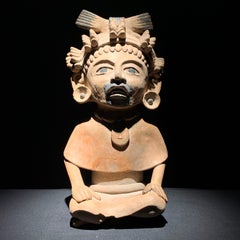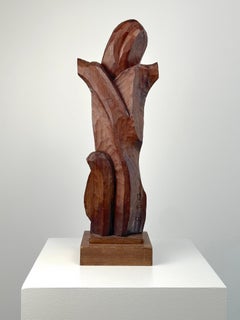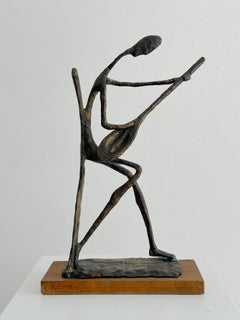Want more images or videos?
Request additional images or videos from the seller
1 of 5
UnknownPre-Columbian, Veracruz Mexico, Napiloa Priestess Rattle figural sculptureca. 550-950 CE
ca. 550-950 CE
$700List Price
About the Item
- Creation Year:ca. 550-950 CE
- Dimensions:Height: 5.75 in (14.61 cm)Width: 4.38 in (11.13 cm)Depth: 1.75 in (4.45 cm)
- Medium:
- Period:
- Condition:
- Gallery Location:Wilton Manors, FL
- Reference Number:1stDibs: LU24525345192
About the Seller
4.9
Platinum Seller
Premium sellers with a 4.7+ rating and 24-hour response times
Established in 2007
1stDibs seller since 2015
423 sales on 1stDibs
Typical response time: 2 hours
Authenticity Guarantee
In the unlikely event there’s an issue with an item’s authenticity, contact us within 1 year for a full refund. DetailsMoney-Back Guarantee
If your item is not as described, is damaged in transit, or does not arrive, contact us within 7 days for a full refund. Details24-Hour Cancellation
You have a 24-hour grace period in which to reconsider your purchase, with no questions asked.Vetted Professional Sellers
Our world-class sellers must adhere to strict standards for service and quality, maintaining the integrity of our listings.Price-Match Guarantee
If you find that a seller listed the same item for a lower price elsewhere, we’ll match it.Trusted Global Delivery
Our best-in-class carrier network provides specialized shipping options worldwide, including custom delivery.You May Also Like
Girafe in Terracotta
By Nicole Doray Soulard
Located in Pasadena, CA
Nicole DORAY SOULARD.
Animal ceramic sculptures, works centered on the forward. Nature and the study of bodies are sources of inspiration for her. She produces animals from all over...
Category
Early 2000s Realist Figurative Sculptures
Materials
Terracotta
$1,913 Sale Price
20% Off
H 19.69 in W 5.91 in D 3.94 in
Maki in terracotta
By Nicole Doray Soulard
Located in Pasadena, CA
Nicole DORAY SOULARD.
Animal ceramic sculptures, works centered on the forward. Nature and the study of bodies are sources of inspiration for her. She produces animals from all over...
Category
Early 2000s Realist Figurative Sculptures
Materials
Terracotta
Angelic Crystal, Atelier, Terracotta
By Richard MacDonald
Located in Laguna Beach, CA
"Angelic Crystal, Atelier – Terracotta" is a radiant expression of purity, ascension, and transformation. Captured in a moment of poised elevation, the female figure is both grounded...
Category
21st Century and Contemporary Contemporary Figurative Sculptures
Materials
Terracotta
Katherine Bust, Atelier, Terracotta
By Richard MacDonald
Located in Laguna Beach, CA
Katherine Bust Atelier, Terracotta draws on Richard MacDonald's unique sensitivity to the experience of the dancer. Based on a classical study for the masterwork Dance the Dream, thi...
Category
21st Century and Contemporary Contemporary Figurative Sculptures
Materials
Terracotta
Angelic Crystal, Terracotta
By Richard MacDonald
Located in Laguna Beach, CA
Intrigued by the stature and carriage of a particular figure, MacDonald pursued Angelic Crystal, the study of a ballerina in the studio. Inspired by a continuing appreciation of danc...
Category
21st Century and Contemporary Contemporary Figurative Sculptures
Materials
Terracotta
20th Century Terracotta French Sculpture Centrepiece Signed Flamand, 1920s
Located in Vicoforte, IT
French centerpiece from the first half of the 20th century. Finely chiseled terracotta object with masks (faces with different expressions, see photo) and figures of lateral cherubs ...
Category
1920s Figurative Sculptures
Materials
Terracotta
$3,168
Free Shipping
H 10.24 in W 22.05 in D 9.45 in
"Wall Piece with Figure, " Terra Sigillata by Christine LePage
By Christine LePage
Located in Milwaukee, WI
"Wall Piece with Figure" is a ceramic sculpture made with Terra Sigillata by Christine LePage. It features a figure in the left half and an abstract ge...
Category
1980s Figurative Sculptures
Materials
Ceramic, Terracotta
$7,300
H 4.5 in Dm 14 in
Man in Window, Terracotta, Sculpture, Orange, Blue, Grey colors "In Stock"
By S. K. Sahajahan
Located in Kolkata, West Bengal
S. K. Sahajahan - Untitled - 8.5 x 8.5 inches
Terracotta.
Sahajahan’s work explores his physical surroundings through figurative contexts. Utilizing texture and and the emotive fa...
Category
Early 2000s Contemporary Figurative Sculptures
Materials
Terracotta
$379
H 16.5 in W 16.5 in D 0.5 in
Couple, Romantic, Terracotta by Contemporary Indian Artist "In Stock"
By Subrata Biswas
Located in Kolkata, West Bengal
Subrata Biswas - Untitled - 20.5 x 32 Inches ( framed size)
Terracotta
Subrata Biswas’s three sculptures ‘Think Green’, ‘Amigo’ and ‘City Bred’ a conscious selection of elements of ...
Category
2010s Contemporary Figurative Sculptures
Materials
Terracotta
$910
H 20.5 in W 32 in D 1 in
Men & Animal, Terracotta, Brown by Contemporary Indian Artist "In Stock"
By Subrata Biswas
Located in Kolkata, West Bengal
Subrata Biswas - Untitled - 31 x 43 Inches ( framed size )
Terracotta
Subrata Biswas’s three sculptures ‘Think Green’, ‘Amigo’ and ‘City Bred’ a conscious selection of elements of f...
Category
2010s Contemporary Figurative Sculptures
Materials
Terracotta
$1,449
H 31 in W 43 in D 1 in
More From This Seller
View AllPre-Columbian Colima Shaman terracotta figure vessel Mexican sculpture
Located in Wilton Manors, FL
Seated Shaman
Colima culture
Mexico
ca. 300 BCE - 300 CE
Pre-Columbian, West Mexico, Colima, ca. 300 BCE to 300 CE. A hollow-cast and highly-burnished terraco...
Category
15th Century and Earlier Figurative Sculptures
Materials
Terracotta
Veracruz Mexico Pre-Columbian ceramic Warrior figure sculpture
Located in Wilton Manors, FL
Figure of a Chanting Warrior
Ceramic with bitumen highlights
300-600 CE (Classic Period)
Mexico, Veracruz, possibly Nopiloa
Veracruz Culture
Pre-Columbian, Mexico, Vera Cruz culture...
Category
15th Century and Earlier Figurative Sculptures
Materials
Ceramic
$6,000 Sale Price
50% Off
Abstract Figure
By Raul Diaz
Located in Wilton Manors, FL
Raul Diaz (Argentina, b.1950). Abstract Figure, ca. 1970s. Canved Walnut. Measures 17 inches tall including wood base. Carved signature in lower region. Excellent condition.
An ear...
Category
1970s Abstract Expressionist Abstract Sculptures
Materials
Walnut
$900 Sale Price
25% Off
Greek Guitar Player
Located in Wilton Manors, FL
Beautiful abstract sculpture depicting a guitar player. Bronze on wood base measuring 15 x 9 x 4 inches. Actual cast piece without base measuring 17 x 7 x 3 inches. Signed indistinct...
Category
Mid-20th Century Abstract Abstract Sculptures
Materials
Bronze
$900 Sale Price
25% Off
Standing Figure
Located in Wilton Manors, FL
Tom Cramer (b.1960). Standing Figure, 1988. Carved wood and polymer paint. Measures 11.5 inches high. Excellent condition. Signed and dated under base.
Tom Cramer is an American artist working in Portland, Oregon noted for his intricately carved and painted wood reliefs and ubiquity throughout the city of Portland. Often called the unofficial Artist Laureate of Portland,[2] Cramer is one of the most visible and successful artists in the city. The influences on his work are both organic and technological. He is widely collected and is in many prominent west coast museum and private collections. He is in the permanent collections of the Portland Art Museum[3] in Portland Oregon, the Halle Ford Museum in Salem Oregon, the Jordan Schnitzer Museum in Eugene, Oregon, the Boise Art Museum in Idaho.
Cramer made a name for himself in the 1980s and 1990s becoming a bridge between historical Oregon artists like Clifford Gleason and Milton Wilson...
Category
Late 20th Century Neo-Expressionist Figurative Sculptures
Materials
Wood, Latex
Portrait of a Man
Located in Wilton Manors, FL
Francisco Vazquez Diaz, known as Compostela (1898-1988). Portrait of a Man, 1949. Carved mahogany, measuring 18.75 inches h, 8.5 inches w, 11 in...
Category
Mid-20th Century Realist Figurative Sculptures
Materials
Mahogany
$8,000 Sale Price
60% Off
Recently Viewed
View AllMore Ways To Browse
Pre Columbian Rattle
Mexican Terracotta Sculpture
Mayan Antique
Mexico 950
Antique Rattles
Pre Columbian Terracotta
Pre Columbian Mexican Art
Pre Columbian Figure
Pre Columbian Rattle
Mexican Terracotta Sculpture
Mayan Antique
Mexico 950
Antique Rattles
Pre Columbian Terracotta
Pre Columbian Mexican Art
Pre Columbian Figure


